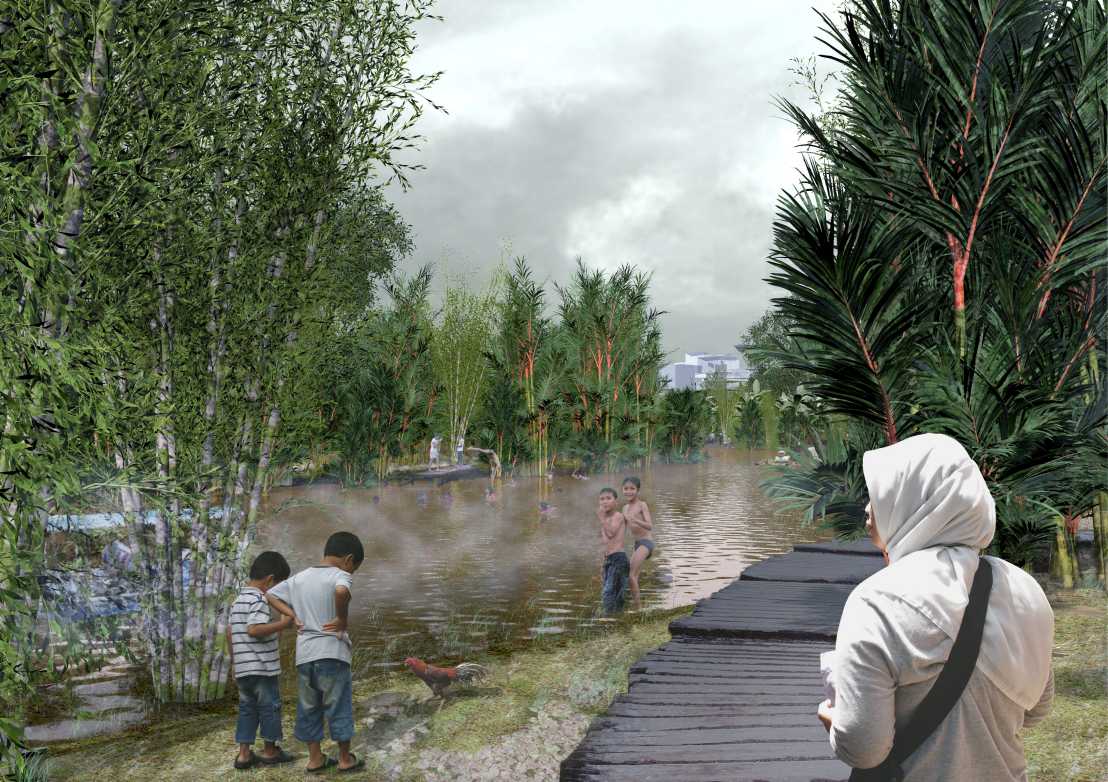Reconciling a city with its river
The inhabitants of Jakarta have a difficult relationship with their river: it’s a waste carrier and an unwelcome guest in houses and on streets during the rainy season. ETH architecture students worked on concepts to reconcile the river with the city. Their ideas are currently on show at the Architecture Biennale in Rotterdam.
Many large cities of the world lie along riverbanks. Many of these rivers provide space for walks; they are an artery of vitality, a source of water. The Ciliwung River, which flows through Jakarta, tells another story: squeezed between haphazardly erected dwellings, the river transports garbage from industrial sources and private households. In the city's informal settlements, there is no organised waste removal; the litter goes directly into the river or is left on informal dumps on the riverbank from where it gets washed into the stream by frequent floods.
“The street is the centre of activities; the river is a neglected backyard,” says Philipp Urech of the Institute for Landscape Architecture at ETH Zurich, describing the situation in the district of Kampung Melayu. The challenge faced by architecture students in the ‘Designing the Ciliwung River’ project was to give the river more space to reduce flooding and integrate it into the cityscape as a green corridor. The students’ ideas are now on show at the Architecture Biennale in Rotterdam in the thematic section of waste management.
More space for water and residents

In close cooperation with ETH Zurich’s Future Cities Laboratory (FCL) in Singapore, the students developed ideas to redesign the riverbed and the residential space in Kampung Melayu. The aim is to give the Ciliwung more space in order to control the massive volumes of water flowing through the city during the monsoon season. The concepts also focused on creating new public spaces, such as squares and gardens of various sizes along the riverbanks.
“The challenge for the students was to think on a spectrum of different scales, from individual housing units to the entire cityscape,” explains Urech, who supervised the students with his colleagues under the direction of ETH-professor Christophe Girot. To create more space for the river and for public areas meant redesigning the housing units to increase the density of the residential areas. “The site visit was highly important for the students,” adds Urech. It allowed them to gather ideas about the amount of required living space and to investigate the existing structures of public space, such as small markets.
Restoring the river to a natural state

A central aspect of the design concept was the modelling of the topography of the riverbed that conveys the water through the city. The students developed milled models to examine the shape of selected segments of the river. The designs also included strategies for waste collection, recycling facilities, spaces for urban farming and parks, and places for workshops and public activity. The goal was to give the residents of Kampung an alternative to the informal waste dumps and to renaturate the river in order to improve the quality for the adjacent dwelling areas.
Together with students from the National University of Singapore and the FCL, the future architects worked on their ideas and tested them in 3D simulations through the ValueLab, the FCL’s simulation module. “We made no requirements in terms of costs or construction methods to give students the freedom to design a vision,” notes Urech.
Although no specific implementation plans are in place, the ideas were shown to decision makers and residents in an exhibition in Jakarta, and now to an expert public in Rotterdam. The project has sensitised students to the problems of flooding, waste management and to approaches that might be transferable to other cities and countries.
Further information
The student project ‘Designing the Ciliwung River’, under the auspices of the Chair of Landscape Architecture of ETH-professor Girot, is presented at the external page International Architecture Biennale in Rotterdam.

Comments
No comments yet